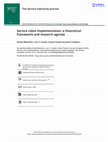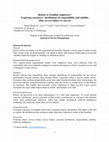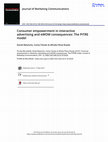Papers by Daniel Belanche

Electronic Markets, 2020
Robots are being implemented in many frontline services, from waiter robots in restaurants to rob... more Robots are being implemented in many frontline services, from waiter robots in restaurants to robotic concierges in hotels. A growing number of firms in hospitality and tourism industries introduce service robots to reduce their operational costs and to provide customers with enhanced services (e.g. greater convenience). In turn, customers may consider that such a disruptive innovation is altering the established conditions of the service-provider relationship. Based on attribution theory, this research explores how customers’ attributions about the firm motivations to implement service robots (i.e. cost reduction and service enhancement) are affecting customers’ intentions to use and recommend this innovation. Following previous research on robot’s acceptance, our research framework analyzes how these attributions may be shaped by customers’ perceptions of robot’s human-likeness and their affinity with the robot. Structural equation modelling is used to analyze data collected from ...

Journal of Service Management, 2021
The automation of services is rapidly growing, led by sectors such as banking and financial inves... more The automation of services is rapidly growing, led by sectors such as banking and financial investment. The growing number of investments managed by artificial intelligence (AI) suggests that this technology-based service will become increasingly popular. This study examines how customers' technology readiness and service awareness affect their intention to use analytical-AI investment services. Design/methodology/approach: Hypotheses were tested with a data set of 404 North American-based potential customers of robo-advisors. In addition to technology readiness dimensions, the potential customers' characteristics were included in the framework as moderating factors (age, gender and previous experience with financial investment services). A post-hoc analysis examined the roles of service awareness and the financial advisor's name (i.e., robo-advisor vs. AI-advisor). Findings: The results indicated that customers' technological optimism increases, and insecurity decreases, their intention to use robo-advisors. Surprisingly, feelings of technological discomfort positively influenced robo-advisor adoption. This interesting finding challenges previous insights into technology adoption and value co-creation, as analytical-AI puts customers into a very passive role and reduces barriers to technology adoption. The research also analyzes how consumers become aware of robo-advisors, and how this influences their acceptance. Originality: This is the first study to analyze the role of customers' technology readiness in the adoption of analytical-AI. We link our findings to previous technology adoption and automated services' literature and provide specific managerial implications and avenues for further research.

THE SERVICE INDUSTRIES JOURNAL, 2019
Service robots and artificial intelligence promise to increase productivity and reduce costs, pro... more Service robots and artificial intelligence promise to increase productivity and reduce costs, prompting substantial growth in sales of service robots and research dedicated to understanding their implications. Nevertheless, marketing research on this phenomenon is scarce. To establish some fundamental insights related to this research domain, the current article seeks to complement research on robots’ human-likeness with
investigations of the factors that service managers must choose for the service robots implemented in their service setting. A three-part framework, comprised of robot design, customer features, and service encounter characteristics, specifies key factors within each category that need to be analyzed together to determine their optimal adaptation to different service components. Definitions and overlapping concepts are clarified,
together with previous knowledge on each variable and
research gaps that need to be solved. This framework and the final research questions provide a research agenda to guide scholars and help practitioners implement service robots successfully.

Journal of Service Management, 2020
Structured abstract
Purpose
Service robots are taking over the organizational frontline. Despi... more Structured abstract
Purpose
Service robots are taking over the organizational frontline. Despite a recent surge in studies on this topic, extant works are predominantly conceptual in nature. The purpose of this paper is to provide valuable empirical insights by building on attribution theory.
Design/methodology/approach
Two vignette-based experimental studies were employed. Data were collected from US respondents who were randomly assigned to scenarios focusing on a hotel's reception service and a restaurant's waiter service.
Findings
Results indicate that respondents make stronger attributions of responsibility for the service performance towards humans than towards robots, especially when a service failure occurs. Customers thus attribute responsibility to the firm rather than the frontline robot. Interestingly, the perceived stability of the performance is greater when the service is conducted by a robot than by an employee. This implies that customers expect employees to shape up after a poor service encounter but expect little improvement in robots' performance over time.
Practical implications
Robots are perceived to be more representative of a firm than employees. To avoid harmful customer attributions, service providers should clearly communicate to customers that frontline robots pack sophisticated analytical, rather than simple mechanical, artificial intelligence technology that explicitly learns from service failures.
Originality/value
Customer responses to frontline robots have remained largely unexplored. This paper is the first to explore the attributions that customers make when they experience robots in the frontline.

Journal of Marketing Communications, 2020
Modern users demand control over their advertising experience and a sense of empowerment througho... more Modern users demand control over their advertising experience and a sense of empowerment throughout the communication process. In response, some platforms have introduced online features that increase users’ control by facilitating ad interaction and electronic word of mouth (eWOM), such as YouTube’s skippable
advertising. Using this prototypical example, the current study develops and proposes a novel, sequential framework that accounts for product involvement, intrusiveness, time watching the ad, recall, and eWOM (PITRE) to describe tactics to increase
advertising effectiveness through consumer empowerment.
Consumers’ involvement with advertised products reduces their perceptions of intrusiveness and enhances their positive ad and brand eWOM intentions. Ad intrusiveness instead increases adskipping behaviour and hinders ad and brand dissemination.
Greater time watching the ad increases brand recall and eWOM intentions, though users do not need to recall the brand to share related ads. These findings offer suggestions for professionals seeking to establish effective online advertising strategies.










Uploads
Papers by Daniel Belanche
investigations of the factors that service managers must choose for the service robots implemented in their service setting. A three-part framework, comprised of robot design, customer features, and service encounter characteristics, specifies key factors within each category that need to be analyzed together to determine their optimal adaptation to different service components. Definitions and overlapping concepts are clarified,
together with previous knowledge on each variable and
research gaps that need to be solved. This framework and the final research questions provide a research agenda to guide scholars and help practitioners implement service robots successfully.
Purpose
Service robots are taking over the organizational frontline. Despite a recent surge in studies on this topic, extant works are predominantly conceptual in nature. The purpose of this paper is to provide valuable empirical insights by building on attribution theory.
Design/methodology/approach
Two vignette-based experimental studies were employed. Data were collected from US respondents who were randomly assigned to scenarios focusing on a hotel's reception service and a restaurant's waiter service.
Findings
Results indicate that respondents make stronger attributions of responsibility for the service performance towards humans than towards robots, especially when a service failure occurs. Customers thus attribute responsibility to the firm rather than the frontline robot. Interestingly, the perceived stability of the performance is greater when the service is conducted by a robot than by an employee. This implies that customers expect employees to shape up after a poor service encounter but expect little improvement in robots' performance over time.
Practical implications
Robots are perceived to be more representative of a firm than employees. To avoid harmful customer attributions, service providers should clearly communicate to customers that frontline robots pack sophisticated analytical, rather than simple mechanical, artificial intelligence technology that explicitly learns from service failures.
Originality/value
Customer responses to frontline robots have remained largely unexplored. This paper is the first to explore the attributions that customers make when they experience robots in the frontline.
advertising. Using this prototypical example, the current study develops and proposes a novel, sequential framework that accounts for product involvement, intrusiveness, time watching the ad, recall, and eWOM (PITRE) to describe tactics to increase
advertising effectiveness through consumer empowerment.
Consumers’ involvement with advertised products reduces their perceptions of intrusiveness and enhances their positive ad and brand eWOM intentions. Ad intrusiveness instead increases adskipping behaviour and hinders ad and brand dissemination.
Greater time watching the ad increases brand recall and eWOM intentions, though users do not need to recall the brand to share related ads. These findings offer suggestions for professionals seeking to establish effective online advertising strategies.
investigations of the factors that service managers must choose for the service robots implemented in their service setting. A three-part framework, comprised of robot design, customer features, and service encounter characteristics, specifies key factors within each category that need to be analyzed together to determine their optimal adaptation to different service components. Definitions and overlapping concepts are clarified,
together with previous knowledge on each variable and
research gaps that need to be solved. This framework and the final research questions provide a research agenda to guide scholars and help practitioners implement service robots successfully.
Purpose
Service robots are taking over the organizational frontline. Despite a recent surge in studies on this topic, extant works are predominantly conceptual in nature. The purpose of this paper is to provide valuable empirical insights by building on attribution theory.
Design/methodology/approach
Two vignette-based experimental studies were employed. Data were collected from US respondents who were randomly assigned to scenarios focusing on a hotel's reception service and a restaurant's waiter service.
Findings
Results indicate that respondents make stronger attributions of responsibility for the service performance towards humans than towards robots, especially when a service failure occurs. Customers thus attribute responsibility to the firm rather than the frontline robot. Interestingly, the perceived stability of the performance is greater when the service is conducted by a robot than by an employee. This implies that customers expect employees to shape up after a poor service encounter but expect little improvement in robots' performance over time.
Practical implications
Robots are perceived to be more representative of a firm than employees. To avoid harmful customer attributions, service providers should clearly communicate to customers that frontline robots pack sophisticated analytical, rather than simple mechanical, artificial intelligence technology that explicitly learns from service failures.
Originality/value
Customer responses to frontline robots have remained largely unexplored. This paper is the first to explore the attributions that customers make when they experience robots in the frontline.
advertising. Using this prototypical example, the current study develops and proposes a novel, sequential framework that accounts for product involvement, intrusiveness, time watching the ad, recall, and eWOM (PITRE) to describe tactics to increase
advertising effectiveness through consumer empowerment.
Consumers’ involvement with advertised products reduces their perceptions of intrusiveness and enhances their positive ad and brand eWOM intentions. Ad intrusiveness instead increases adskipping behaviour and hinders ad and brand dissemination.
Greater time watching the ad increases brand recall and eWOM intentions, though users do not need to recall the brand to share related ads. These findings offer suggestions for professionals seeking to establish effective online advertising strategies.